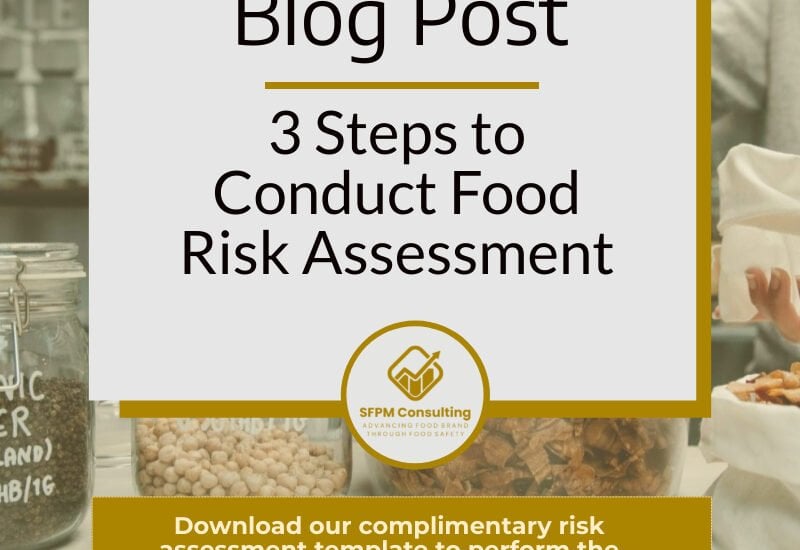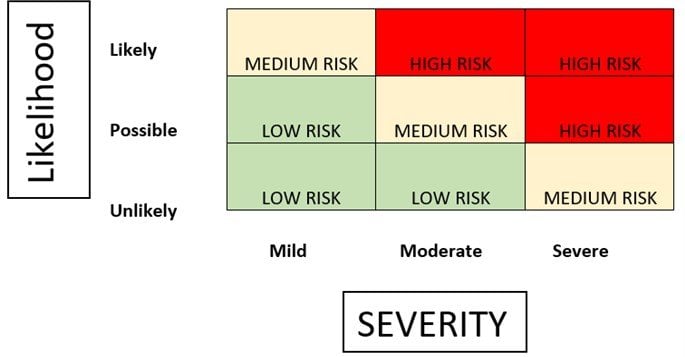3 Steps to Conduct Food Risk Assessment
- January 24, 2023
- Posted by: Felicia L
- Category: Food Safety

3 Steps to Conduct Food Risk Assessment
Food safety is a top priority for many people, and rightfully so. After all, eating food that has been contaminated with harmful pathogens can be very dangerous. But what about the food we eat every day – foods we assume are safe?
Food risk assessment is important for ensuring that our food is safe. In this blog post, we will discuss a food risk assessment, how to conduct one, and some examples of hazard, probability and severity to consider when assessing risk. We will also provide a guide for determining your risk level based on these factors.
Step 1: Identify Food Safety Hazard: What can go wrong?
What is a food safety hazard?
According to the CFIA, a food safety hazard is any agent that can potentially cause adverse health consequences to consumers. Food safety hazards can occur due to exposure to hazardous agents, resulting in food contamination. This may be due to the input materials such as ingredients, packaging materials, water, gases or through processing steps or due to processing surroundings.
These hazards are typically categorized as biological, chemical and physical hazards.
Biological hazards
Biological hazards refer to the hazards due to pathogenic bacteria, parasites, viruses, prions, mold and yeast that can cause food-borne illnesses or harm consumers. Example of common pathogens and viruses that causes food recalls are Salmonella spp., Listeria monocytogenes, E.coli O157:H7, noroviruses and many more. They may be introduced through the process or present naturally in the food.
Chemical hazard
Chemical hazards refer to any chemical or contaminants that may be introduced at the growing stage, harvesting or during the processing or post-processing stages. Examples of chemical hazards are
- environmental contaminants such as arsenic, cadmium, lead, mercury
- pesticide
- herbicides
- veterinary drug such as antibiotic residues
- mycotoxin such aflatoxin, orchatoxin A, patulin
- natural toxin such as glycoalkaloids
- marine toxins such as paralytic shellfish poisoning (PSP), amnesic shellfish poisoning (ASP), ciguatera poisoning, diarrhetic shellfish poisoning (DSP), tetrodotoxin poisoning
- non-food grade chemicals such as the use of food additives above approved regulatory limits, cleaning agents, sanitizing agents, lubricants
- food allergens such as peanuts, tree nuts, fish, sulphites
Food fraud tips: It is important to include hazards associated with food fraud, where food may be substituted with other chemical contaminants for economic gain. For example, red chilli flakes have been commonly known for adulteration with Sudan dye.
US FSMA Plan Tips: When you work with the US FSMA Preventive Control Plan, remember to add the introduction of radiological hazard assessment.
Physical hazards
Physical hazards refer to foreign hazardous extraneous materials that are not supposed to be present with the food but may be introduced during the growing, harvesting or processing. These foreign hazardous extraneous materials can cause a variety of hazards to the consumer, such as choking, cutting the digestive tracks (for sharp objects), breaking teeth etc. You may not think of these as foreign materials or physical hazards, but they can be: bone pieces, seeds in the product sold as seedless, etc.
Other common physical hazards present in the facility environment include plastic pieces, wood pieces, metal pieces, paper pieces etc.
So, how do we put these hazards together in an efficient way to manage the risk?
That’s where hazard analysis comes in: It helps you assess risk by identifying the potential hazards associated with a particular product or process step.
How do you find the hazard for your food products or process steps?
Here are some common references that you can use for your hazard assessment
- Recall history associated with the food products
- Recall history associated with the manufacturer or distributors
- FDA Guidance document for food-related hazards
- CFIA Hazard Database for food products and processes
It is important to be reminded that correctly identifying the food and process-related hazards is important to ensure that you conduct food risk assessment correctly.
Step 2: Conduct Food Risk Assessment: How Bad It Can Get?
In the food industry,
We conduct a food risk assessment to determine the food safety risks for the food products we process to ensure that we ensure the food is safe for the consumers. In fact, food risk assessment is a common practice that we use for developing and implementing Hazard Analysis and Critical Control Points (HACCP). HACCP is the fundamentals for Canadian Safe Food for Canadian Regulations and US Food Safety Modernization Acts.
Naturally, food risk assessment also serves as fundamentals for globally recognized food safety certifications such as SQF, BRC, FSSC 22000, and Primus GFS, to name a few, as we can use the hazard risk assessment framework to identify process control and critical control point to reduce or mitigate the identified risks.
You must conduct the food risk assessment to meet requirements for the country of manufacture and known country of sale.
What are the factors that we need to consider for food risk assessment?
After we determine the hazard, we need to consider two factors -probability and severity.
Risk level: Determine risk level based on probability and severity
Risk is the equation of probability and severity.
In short,
Risk = probability x severity
The use of a risk matrix can help to guide your risk assessment. Many risk matrices are available, so which risk matrices should I choose? You and your food safety team must choose the right risk matrix that applies to your processes.
When we perform risk assessment, we typically choose the 3 by 3 risk matrix, as it is the easiest to maintain and help our client understand their risks. At SFPM Consulting, we want to ensure we deliver food safety plans that our clients can understand, use and manage.
The 3 x 3 risk matrix is really easy to use. Start with a particular hazard.
Then, you will assess the probability and severity. Find the intersection point that is your risk level.
Download this Food Risk Assessment Template
Probability: How likely is it that something will happen?
Probability is the measure of how likely something is to happen. When it comes to assessing risk, we need to understand three things: hazard (what might happen), probability (how often it will happen), and severity (the impact if it does occur).
Is this likely to occur? Assess if this is not going to happen (unlikely), can happen (possible), or is common (likely). Make sure you note down the justification for your analysis.
For example, the presence of glass in products stored in glass -can be present (likely) due to past glass incidents with the supplier. This may vary depending on your product, processes and supplier credibility.
Severity: How serious would a problem be if it happened?
Severity refers to how serious the hazards are to the consumers.
Mild severity hazards can potentially be minor quality defects that don’t cause food safety issues but may cause customer complaints.
Moderate-severity hazards can cause moderate harm but not death or injury. For example, the presence of lead does not cause immediate harm but can cause harm due to lead accumulations.
Major severity hazards can cause food-borne illness, death or harm to consumers. For example, the growth of Botulinum clostridium can cause food-borne illnesses, or the presence of allergens can lead to severe anaphylaxis reactions and potential death.
Step 3: Reduce or Mitigate Identified Risk
The fundamental of identifying food risk levels is determining how to control the risk. All risk levels must be controlled. However, the control strategies vary depending on the risk level we identified. As identified in our HACCP plan, we commonly manage food risk through Good Manufacturing Practices or Prerequisite programs. This applies to all hazards.
Hazards with high-risk ratings must be controlled further through other mitigation strategies, either through a critical control point or other monitoring strategies. For example:
- The presence of declared allergen must be controlled through Allergen Labelling steps (or similar, depending on your processes).
- In acidified foods, pathogens such as Clostridium botulinum growth must be controlled through acidification and cold temperature storage.
- Use of metal detector to control metal pieces.
- Use of x-rays to detect bone presence in meat products.
Food Risk Assessment Applications.
This blog shares a simplified introduction to performing the food risk assessment. You can use these steps to perform a risk assessment for your processes, especially when modifying a process step or deviating from common Good Manufacturing Practices.
Download this Food Risk Assessment Template
Risk Assessment for SQF Program
In the SQF 9.0 requirements, multiple risk assessments must be conducted for a few specified elements, especially in Module 11. Be sure that you are conducting your food risk assessment for your facility.
Risk Assessment for HACCP Program
The first principle of HACCP is conducting a hazard assessment. You must conduct a hazard assessment when you
- develop your first HACCP plan;
- when there are any changes to ingredients and processes, regulatory changes, or new hazards are identified
- regularly, at minimum once annually, to ensure that your risk assessment is current.
Risk Assessment for US FSMA PCP Plan and SFCR PCP Plan.
See risk assessment requirements for the HACCP program. It is important to note that identifying your risk earlier and ensuring a mitigation step can help reduce food recall and harm to the brand and consumers.
If you are working with US FSMA PCP Plan, here is a quick hint for you to add sesame as part of your hazards.

